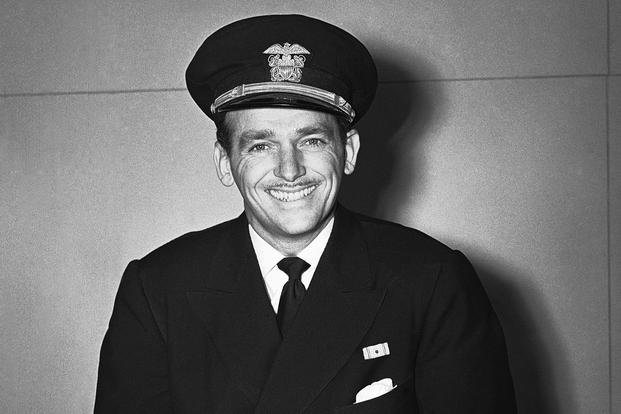During the early portion of actor Douglas Fairbanks Jr.'s military service during World War II, he yearned to do more. British Adm. Lord Louis Mountbatten, a longtime family friend, gave him that opportunity.
As leader of Combined Operations overseeing Britain’s commando warfare, Mountbatten headed an officer exchange program where they learned about explosives, deceptive tactics and the art of misdirection. Originally commissioned a lieutenant junior grade in the U.S. Naval Reserve, Fairbanks was invited to participate and became enthralled.
After returning stateside, Fairbanks pitched the idea of a similar program for the U.S. military. The suggestion was endorsed by Adm. H. Kent Hewitt and the powers-that-be in Washington, leading to a letter seeking 180 officers and 300 enlisted men for a new program being posted at naval bases and on select U.S. university campuses in 1943.
"The Navy is requesting volunteers for prolonged, hazardous, distant duty for a secret project," the announcement said.
While Fairbanks appeared in about 100 movies -- including "The Prisoner of Zenda," "Gunga Din" and "The Corsican Brothers" -- his role in creating the Beach Jumpers was likely the most impactful he ever had. Considered a precursor of the Navy SEALs, the Beach Jumpers used tactical cover and deceptive practices in military operations. They would make it appear an amphibious landing was occurring in one location, when the actual target site was elsewhere. In the process, the enemy's attention and resources were diverted, costing it precious time and leading to confusion.
To do this, the Beach Jumpers employed tools to aid their deception, including:
- Smoke generators
- Roman candles that could be tossed in the water to mimic gun flashes
- Radar-jamming equipment
- 25-foot-long balloons covered with metal to stymie radar operators
- Time-delay explosives
BJs also broadcast recorded noises that simulated an invasion.
"I created the [invasion sound] effects by recording boat engines, bos'n [boatswain] whistles, tank engines from a nearby Army training site, [and even] anchor chain sounds by pulling a chain over the edge of an old bucket," Navy radioman Bob Rainie said.
Beach Jumpers, who trained at Ocracoke Island in North Carolina, were assigned air-sea rescue (ASR) boats that could carry an officer and six sailors. They weren't big enough, though, to transport much ammunition, making the need for deception all the more vital.
Because his rank was not high enough, Fairbanks could not command the Beach Jumpers. Instead, he was made a special operations officer and put in charge of coordinating all plans with the British.
The Beach Jumpers were first deployed during Operation Husky, the Allied invasion of Sicily that began in July 1943. Beach Jumper Unit-1 (BJU-1) was tasked with creating a diversion off Cape San Marco -- 100 miles west of the scheduled landing area. Although the mission was delayed by a day because of treacherous seas, it was successful and was credited with distracting an entire German reserve division.
A year later, three BJ units were awarded the Presidential Unit Citation for their involvement in Operation Dragoon, the invasion of southern France. Their mission was to make it appear that landings could occur anywhere from Marseille, France, to Genoa, Italy -- roughly 250 miles. Seventy officers and 400 sailors were assigned to a 40-ship task force that was split equally into two diversionary groups.
Operation Dragoon, often referred to as the second D-Day, began on Aug. 15, 1944.
“The day before the Dragoon invasion, Fairbanks, stationed on board British gunboat Aphis, led diversions against eastern coast targets between Genoa and Cannes,” according to a 2018 article in World War II magazine. “Four of his PT boats simultaneously landed Free-French commandos at Deux Frères, a coastal promontory near Cannes. At 2 a.m., with the commandos ashore, Fairbanks’s flotilla swung west to join the other diversion team.
Although the Allies disagreed about Operation Dragoon -- British Prime Minister Winston Churchill was against it -- the four-week mission liberated most of the region, opened key ports and dealt heavy losses to German troops.
Eleven Beach Jumper units were deployed globally during World War II. Shortly after the war, all BJUs were deactivated, although they were later involved during the Korean and Vietnam wars, as well as the Cuban missile crisis and Cold War. The public was not made aware of the Beach Jumpers' existence until John Barry Dwyer's 1992 book, "Seaborne Deception: The History of U.S. Navy Beach Jumpers."
None of the Beach Jumpers who were involved in World War II are alive today, according to the U.S. Navy Beach Jumpers Association.
Fairbanks, who returned to the Naval Reserve after WWII and retired as a captain in 1954, became a highly decorated service member and was known as the “Father of the Beach Jumpers.” While Fairbanks lived an eclectic life before dying in 2000 at age 90, he held a special fondness for his time in the military.
"I'd put it very high up, very high up indeed," Fairbanks told the U.S. Naval Institute in 1993.
-- Stephen Ruiz can be reached at stephen.ruiz@military.com.
Want to Know More About the Military?
Be sure to get the latest news about the U.S. military, as well as critical info about how to join and all the benefits of service. Subscribe to Military.com and receive customized updates delivered straight to your inbox.
















